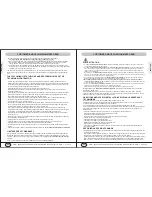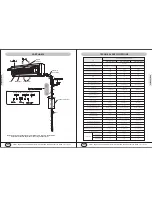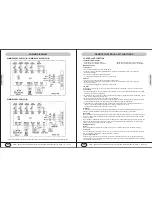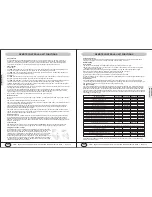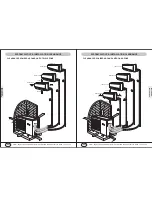
1) The YMGI
Limited Product Warranty Policy
, details the eligibilities, coverage's and other explanations of the warranty
terms between YMGI group and the unit owner.
2) The YMGI
Limited Product Warranty Policy
and the
Warranty Registration Card/Form
are either included inside the
user's manual and/or installation instruction manual, or come separately in the unit packaging box/envelope. If for any
reason they are not included with your shipment, contact our sales or customer service to request a copy (electronic or
printed), prior to installation.
3) The checklist, in the
Warranty Registration Card/Form
, is for the currently licensed/ certified HVAC technician to fill out
completely, while
verifying all unit functions are operating correctly. This checklist is for the technician to test and check all
details of your unit, to verify and ensure its proper operation.
4) The technician must complete all fields in the
Warranty Registration Card/Form
, especially the unit model and serial
numbers and distributor information, and most importantly, the technician checklist.
5) Warranty Registration Card/Form
shall be mailed,
along with the original copy of the currently licensed HVAC
contractor's full installation invoice
, to YMGI Group, within 7-days after original installation, in order for YMGI to review
and process your warranty registration.
6) Keep a copy of
Warranty Registration Card/Form
for your own use in the future, to aid in any possible future warranty
claiming, any request of parts, customer service, and/or technical support.
7) YMGI reserves the right to approve or deny the warranty status based on the information reviewed.
Mailing address of the
Warranty Registration Card/Form:
Warranty Department, YMGI Group, POB 1559,
O'Fallon, MO 63366, USA.
Following these requirements will aid in ensuring the units will be installed to the general HVAC practicing
standards and are necessary factory requirements, to
find problems early, prevent possible damage to the unit
and help ensure the unit will work properly for its life time.
QUESTIONS ABOUT SELF-INSTALLATION VS HIRING LICENSED HVAC
TECHNICIANS
Does YMGI allow to do-it-yourself installations (DIY) partially or fully? NO.
Unfortunately no brand or manufacturer can take the responsibility of the equipment if it is not professionally
installed by a currently licensed HVAC technician/ contractor.
If unit is installed by non-licensed people, in part or fully, will the factory warranty be void? YES.
Some DIY installations have been successful, but these are exceptions. Most have resulted in equipment failure,
due to lack of knowledge and experience. A few of the problems result from DIY's lack of knowledge in the
following areas:
* Sizing and selecting correct type, size and model of cooling and/or heating equipment.
* Sizing and installing correct electric circuit breakers and wires.
* Wiring the units correctly and properly.
* Taping the ends, connecting to indoor and outdoor units correctly and properly.
* Vacuuming the inter-connecting refrigerant lines.
* Checking and/or fixing the refrigerant leaks.
* Checking and/or fixing the condensate drain leaks.
* Releasing the refrigerant from outdoor unit to indoor unit.
* Running the unit to check all the unit functions.
* Conducting the installation or trouble-shooting with correct tools, experience or professional knowledge to
correct the problem.
RECEIVING AND FREIGHT DAMAGE
ATTENTION
* Freight (package/unit) shall be checked thoroughly for damage at receiving before accepting by signing on the
carrier's delivery paperwork.
* Upon shipment being signed for acceptance, it becomes a binding document as to the condition of the products
on delivery. We cannot process any shipping damage claim, if you accept the delivery.
* If damage is found at delivery, both you and the delivery driver must make notes on the delivery receipt or other
freight paperwork detailing the damage found by marking position/parts on unit, description of damage, time/
date, your name, contact phone, etc. on the delivery documents. Make a copy of the marked delivery receipt.
CUSTOMER AND TECHNICIAN MUST READ
MUST READ
MUST READ
P7 OF 40
P8 OF 40
YMGI, Engineered Comfort Products for A Sustainable and Efficient Green World !
YMGI, Engineered Comfort Products for A Sustainable and Efficient Green World !
The cost of not having your unit installed properly can be more expensive than spending the little extra money
that hiring the right contractor will cost. Protect your investment and warranty eligibility by doing it right the first
time.
THE FOLLOWING LISTS THE JOBS AND RESPONSIBILITIES OF THE
TECHNICIAN/ CONTRACTOR:
* Performing a load calculation for the room(s) you would like to air condition. Cooling requirements will be
different from the heating requirements. They will consider cooling hours, heating hours and your special needs
or requirements. Supplemental heating such as baseboard heater or portable heater may help you save money
by not over-sizing or under-sizing the heating equipment.
* Selecting the right type, size or model of cooling and/or heating equipment.
* Determining the best location to install the unit. (Positioning indoor unit, outdoor unit and running the inter-
connecting pipes/wires.)
* Selecting the correct electrical components (HVAC circuit breaker or fuse and disconnect switch for the electric
power to the outdoor unit, types and sizes of the connecting wires between circuit breaker/disconnect switch
and outdoor unit, and the wires between outdoor unit and indoor unit).
* Keeping the indoor unit away from the ceiling and the outdoor unit away from the wall, bushes and other
obstacles at a proper and safe distance to allow for the proper airflow through the unit's.
* Placing the units on a secured level structure.
* Taping and sealing both ends of the inter-connecting pipes, before running them through structures, to prevent
dust or other debris from getting into the pipes otherwise they will contaminate and damage the refrigeration
system. Failure to follow this practice will make your factory warranty void.
* Connecting the inter-connecting pipes between the outdoor and indoor units. Checking for leaks through
pressurization with nitrogen. After releasing nitrogen, evacuate the piping and indoor unit, for removal of system
contaminants. Finally refrigerant introduction and adjustment, if necessary, from the outdoor unit.
* Back-seating the stopping valves at outdoor condensing unit to release pre-charged refrigerant from outdoor
unit to indoor unit.
* Measuring and recording the electrical voltages at different terminals and the refrigerant pressures at stopping
valves of outdoor condensing unit.
* Verifying and ensuring the unit is connected to the proper electrical power supply.
* Adjusting refrigerant levels (if necessary) following the installation instructions or chart on the unit.
* Checking for any unusual noises and other abnormalities that might be present.
* Operating the unit and check all functions, one by one, and explain to the owner how to operate and maintain
the unit.
* Completing all fields in detail on the installer checklist, signing and dating the
Warranty Registration Card/Form.
LIMITED PRODUCT WARRANTY
If the installation is successfully and fully done by a qualified licensed/ certified HVAC technician/contractor,
the
registration card/form is filled completely and correctly, and filed along with a valid installation invoice from the
contractor company within 7 days of the original installation, the following standard
Limited Product
Warranty
is
qualified:
5-year on compressor and 1-year other PARTS ONLY. There is
no labor coverage
.
12) If the contractor(s)/technician(s) are experienced with the systems/brands you purchase.
You might spend less. But remember, many times you get what you pay for.
13) Sign a contract with them. The contract should list all the detailed work they will conduct and the standards
they will follow. Some contractors are willing to include a 1-year installation/service warranty at no extra
charge. Check with them to see if that is available. If available, include that in the contract.
14) Verify and confirm the installation is done completely and all the unit functions have been checked and are
working properly, all the items in the checklist have been checked and marked well in the warranty registration
card/form, prior to paying the contractor in full.
CUSTOMER AND TECHNICIAN MUST READ





